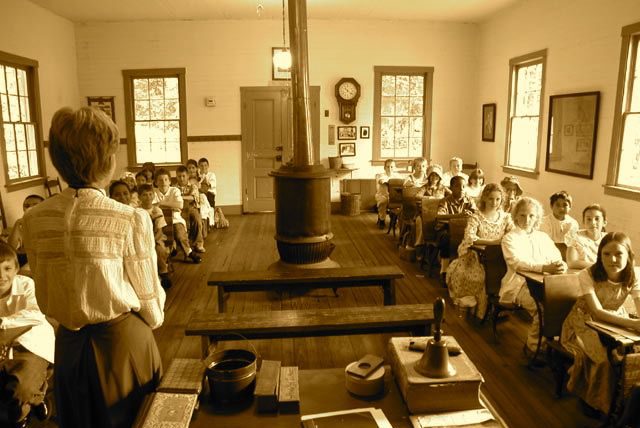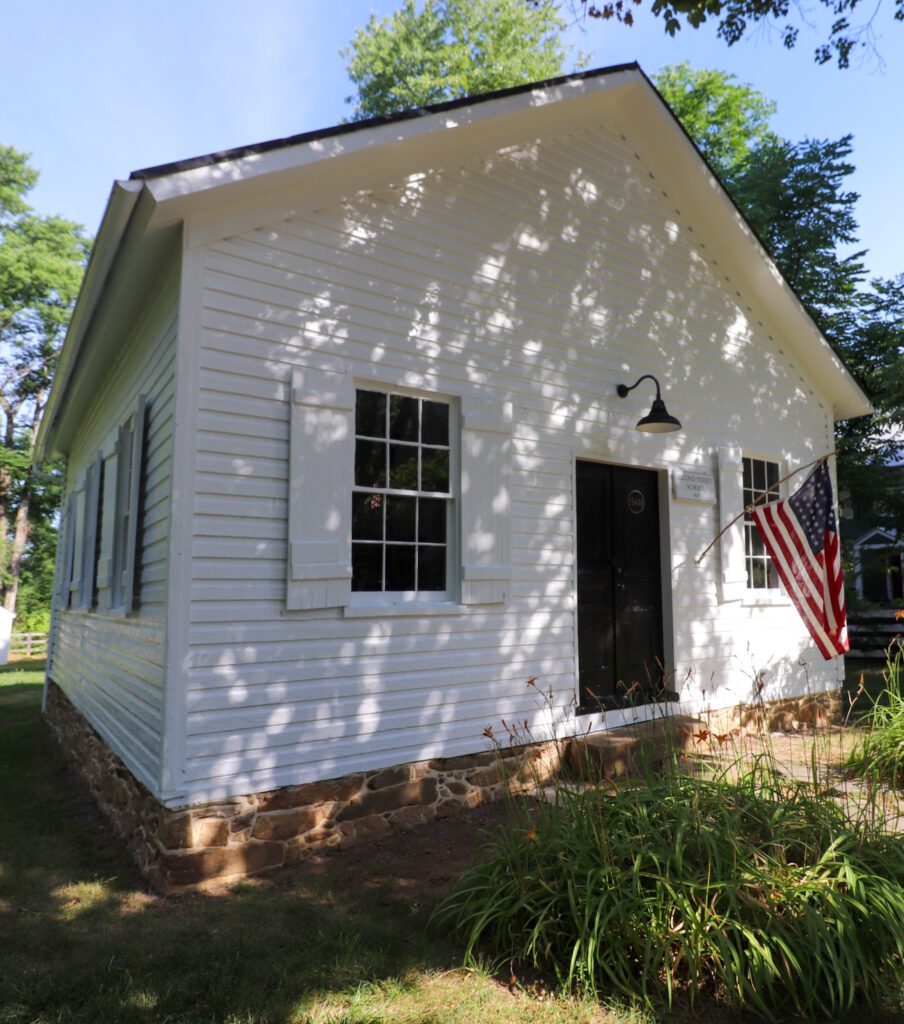
Second Street School
Second Street School Living History Program
Bring your students to experience a day in the life in a one-room African American schoolhouse in the 1880s! Since 1984, The Second Street School Program, developed with the help of the National Endowment for the Humanities, has guided students to understand life for the Black community of Waterford during Reconstruction through the lens of actual students who attended “Colored School A”. This program is designed to support the teaching SOL standard VS.8. Read on below to learn more about our program!
How does this program work?

This program day is based around the Second Street School in Waterford. The building is interpreted to look as much like the 1880s as we can. Before coming to the program, the Waterford Foundation will provide teachers with biographies of students who attended the School in 1880. Students are able to learn about these students, and how historians research people and places from the past.
On the program day, a trained Waterford Foundation docent will be leading your class through various activities. Upon arrival, the docent will board the bus and lead your class through a bus tour of Waterford. Once back at the Second Street School, the docent will welcome your students to 1880 as ‘historians’ studying Reconstruction.
Students are lead through actual lessons that were taught here in the 1880s- including reading, spelling, ciphering, singing of a song, and quill pen writing. After lessons, we have time built in for recess with games and toys from the 1880s.
We also have built in time for your students to ask questions about Reconstruction and life here in Waterford. During this time, students are encouraged to draw comparisons between life in Reconstruction to today, as well as for Black and White Americans.
Logistics
How many students can we accommodate?
We can accommodate up to 30 students in one day.
How long does the program take, and what is the schedule of the day?
This program takes two hours to complete, from 10:00am-12:00pm. Classes are able to have lunch in the yard of the Second Street School afterwards (the Waterford Foundation can provide tarps for students to sit upon). Here is an example schedule of the day:
- 10:00 AM- Bus arrives to the Second Street School
- 10:05-10:20 AM- The docent leads your class through a bus tour of Waterford
- 10:20-10:30 AM- The docent welcomes your class to the Second Street School in 1880. Students are able to sit in the seat of the student that they studied.
- 10:30-11:15 AM- Lessons from 1880 are taught by the docent, Miss Nickens
- 11:15-11:30 AM- Recess
- 11:30-11:45 AM- Final lesson with the singing of “Swing Low Sweet Chariot”
- 11:45 AM- 12:00 PM- Question and Answer time
- 12:00 PM- Class is dismissed
- 12:00-12:30 PM – Lunch in the school yard (optional)
How would transportation work?
Buses will be provided with a map of the Village for a short bus tour. Afterwards, there is bus parking on the side of the Second Street School. When booking a LCPS bus, please put both the Second Street School (15611 Second Street, Waterford VA 20197) and the Waterford Elementary School (15513 Loyalty Road, Waterford VA 20197).
Are there any teacher materials available?
Once a class is booked, teachers will be provided with orientation materials, a pre-lesson for your students to prepare, biographies of students, and other needed materials through this link.
How much does this program cost?
This program costs $100 per class. Proceeds of this program goes to support the educational mission of the Waterford Foundation.
When is this program available, and how does booking work?
This program is available during the spring, from March- May. Dates are available first come, first serve. Spring 2026 booking link is live! LCPS teachers, there are some dates listed that are LCPS holidays so please make sure that you double check.
We want to work with you to make sure that your field trip at the Second Street School is as best as it can be! Please reach out to the Waterford Foundation offices for any questions about this program by email or phone:
540-882-3018 x2
oldschool@waterfordfoundation.org
Teachers: Visit the Teachers’ Page (password needed) to access documents to prepare your classes for their Second Street School program.
History of the Second Street School
In 1867 the first public school for Waterford’s African American community was built at the corner of Janney and Second streets, on land that Quaker Reuben Schooley (1826-1900) sold to the “colored people of Waterford and vicinity.” At that time it was known as the “Colored School ‘A,’ Jefferson District.” Today it is known as the Second Street School. The local African-American population, with financial help from the Freedmen’s Bureau and Quakers, erected the building which was used as both a school and for church functions. This is one of the first one-room schoolhouses for Black children in Loudoun County and is one of the earliest African-American houses of worship.
The simple one-room frame school on Second Street was built just two years after the Civil War ended. Opened under the auspices of the Freedmen’s Bureau, it was Waterford’s first school for the Black community. The Friends’ Association of Philadelphia, Waterford’s local Quaker meeting, and a “colored educational board” provided additional support. The first teacher was Miss Sarah Ann Steer, a Quaker living down the street who had begun teaching pupils in 1865. Subsequent teachers were all from the Black community.
Early classes were large. The District Superintendent’s report to the Freedmen’s Bureau in 1868 recorded 63 students enrolled, with an average attendance of 42. Twenty-eight were older than 16 years. By the early 1870s the school became part of the county’s new public school system.
Black children from the village and nearby farms attended the school until 1957, when it was closed by the School Board. From then until 1965, Waterford’s African-American students were bussed to Leesburg to consolidated schools. Waterford’s present brick elementary school—“the new school”—opened its doors as an integrated school in 1965.
The Second Street School served from the beginning as church as well as school. African Methodist Episcopal services were held here until 1891, when John Wesley Church was built at the other end of the village near Waterford mill. One student recalled attending Baptist services at the school around the turn of the century. Recognizing its historic significance, the Waterford Foundation acquired the building in 1977.